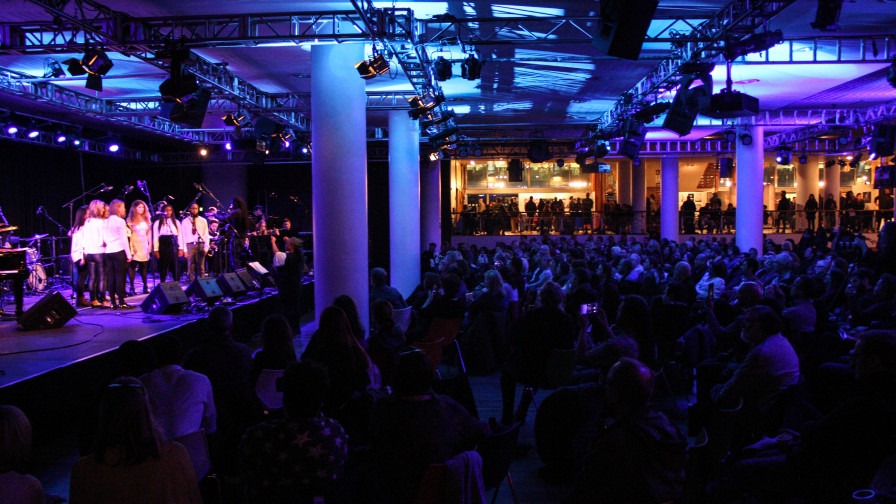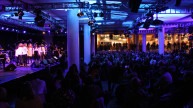Tackling the Big Issues with Young People Through Music-Making

ArtsTrain’s Music Leader/ Composer/ Producer James Yarde reflects on his experience delivering an innovative two year creative project responding to the controversial topic of ‘Gentrification’. The project, which works towards a performance at the EFG London Jazz Festival, brings together young people from diverse musical and social backgrounds to write and compose original music. To hear the finihsed pieces have a listen here https://soundcloud.com/arts-train/sets/artstrain-gentrification-ep
In this blog James shares his thoughts in four key areas:
- Getting The Pitch Right - “Find an engaging entry point and break the topic down into key humanly relatable, simple perspectives.”
- Engaging and Retaining Young People - “Develop a working environment that feels authentically professional, but leave spaces for young people to socialise and enjoy the full creative process. Make sure that young people feel heard and valued right the way through the project”
- Striking the Balance Between ‘Quality’ and ‘Ownership’ -“Make key decisions early and weave the young people into the composition process as much as possible, trusting them to come up with great ideas and starting points”
- Uniting young people from different musical backgrounds - "Explore the non-obvious ways to develop young people’s musical skills regardless of their level of musicianship. Aim to deal with young people as artists whom I’m producing, rather than simply as musicians who are going to perform a piece. Young people’s characters and perspectives become as important as the instruments they play, or how skilled they may be.”
GETTING THE PITCH RIGHT - HOW TO PITCH A TOPIC LIKE 'GENTRIFICATION'?
On the morning that we introduced the topic to the group of young musicians aged 13-18, we asked the question," How many of you know what gentrification is?” Zero hands went up. Not one. Thankfully, Eska and I had predicted that this might well be the case. I mean, who as a teenager, especially in suburbia, is having conversations in which the word ‘gentrification’ is used? I imagine that even those who are directly affected by it probably aren’t throwing that particular word around. Without any context it’s hardly the most exciting topic, the word itself even sounds grey and political. At that point the onus is on us to make sure that our group understand what it is, develop a real interest in the topic, and that they are able to form some kind of emotional bases from which to create from. Not easy.
We found three main layers of media attack
- We played them a video which described (in about a minute tops) what Gentrification was, with text and images so they could read and watch rather than hearing us sound and look like their school teachers.
- We played a deeper video introduction from ArtsTrain Patron and MOBO award winning artist Soweto Kinch, who sets the creative brief for this project. This gave the group a more detailed idea of his particular perspective on it and its effects, and encouraged the young people to respond.
- The most engaging element by far…we played them a highly relevant episode of South Park, suitably edited to remove colourful language of course.
We then presented four main points of perspective for those who might be affected
- New Businesses
- Old Business
- New Residents
- Old Residents
We invited the group to see the issues, through the lenses of these four groups. Role plays and discussions also formed a key part of exploring the four perspectives based on what they know from experience, plus what they imagined and could empathise with. These four key perspectives served as the foundation for the compositions and songwriting
Find an engaging entry point and break the topic down into key humanly relatable, simple perspectives.
HOW TO STRIKE A BALANCE BETWEEN 'QUALITY' AND 'OWNERSHIP'?
I've always felt it important, in this work, to raise the levels of quality or creativity beyond what is generally expected by the participants in some way or another. It’s important that during the creative process or whilst delivering the performance that they have a feeling of excitement about the work. This generally comes from them stepping into relatively new musical territory and from them feeling like they have ownership of the piece.
Often we work with young people who aren’t necessarily the most confident when it comes to creating pieces, nor are they often fully aware of the value of their ideas, or the power of their imagination.
To best succeed in this instance Eska (Artist/Facilitator) and I created the following format:
- Introduce the topic and place the young people into four groups, based on the four perspectives listed earlier, and guide them through a composition process. The groups were invited to identify one key emotion that they would express from their particular perspective and create a graphic score for musical elements that they would follow to give their piece some shape.
- The groups then shared their work with the whole group at the end of the session. We recorded the performance of these pieces and used elements of the short compositions as the basis of our work, exploring and expanding motifs, melodies and chords as we might do if we had come up with them ourselves in a writing session.
- During the composition I supplemented their ideas, heavily in some places and lightly in others, with our own creative elements, vision, skill, taste and experience. Where possible, I try to tailor musical parts to specific musicians’ characters, levels of proficiency and confidence. I try to make the music enjoyable to play and allow for the musicians to shine, mindful and aware of the strengths of musicians.
- When coming back to the group and introducing the new composition I connect the dots, explaining where their ideas feature or play a role in the piece and how they inspired my further composition.
Make key decisions early and weave the young people into the composition process as much as possible, trusting them to come up with great ideas and starting points. Tailor the work to the musicians and as you paint the bigger picture and show them where their ideas are within it.
HOW TO ENGAGE AND RETAIN YOUNG MUSICIANS THROUGH THE CREATIVE PROCESS?
I personally strive to create an atmosphere that feels like a departure from the formality of school, I get to create a space where the young people are to be seen and heard, not just by me, but by themselves and others within the group. For some young people this doesn’t happen often. It is essential to create a space comfortable and safe enough to allow a free flow of ideas and opinions. We are there to work and we are serious about it, but I believe also that the work should be enjoyable, after all music is something that you play.
I seek to guide them through a similar process, albeit shorter, as I would an artist in a studio, of learning about their musical tastes and what they have to say. A solid amount of time and effort is also spent loosening them up physically, inviting and encouraging them to be in their bodies as opposed to existing predominantly in their heads, as many of these young people are.
Develop a working environment that feels authentically professional, but leave spaces for young people to socialise and enjoy the full creative process. Make sure that young people feel heard and valued right the way through the project.
HOW TO UNITE GROUPS OF YOUNG PEOPLE FROM DIFFERENT MUSICAL BACKGROUNDS?
Music is a great way to unite young people from different backgrounds and I make a point of asking what individual musical preferences there are within the group, making sure that we all learn a little bit about each others backgrounds and personal tastes. Often the music that school ensembles play or that young people learn, is vastly different from that which they actually like and enjoy in their own free time. Finding common ground between the group is important as is valuing people’s different backgrounds and interests.
Finding out people’s tastes often throws up similarities between different groups of young people and this common ground can unite young people from totally different background and spark interesting conversations and inspirations for me, as well as them.
Explore the non-obvious ways to develop young people’s musical skills regardless of their level of musicianship. I aim to deal with young people as artists whom I’m producing, rather than simply as musicians who are going to perform a piece. Treat all young people equally and give them the same level of professionalism and respect. Young people’s characters and perspectives become as important as the instruments they play, or how skilled they may be.


